Three Cities, One Exhibition: LON/MSP/NYC at The Soap Factory
The 8 x 8 x 8 exhibition (which runs through June 11th at The Soap Factory) is large and sprawling; Alex Starace isolates and discusses a few of the films and photographs at the show.
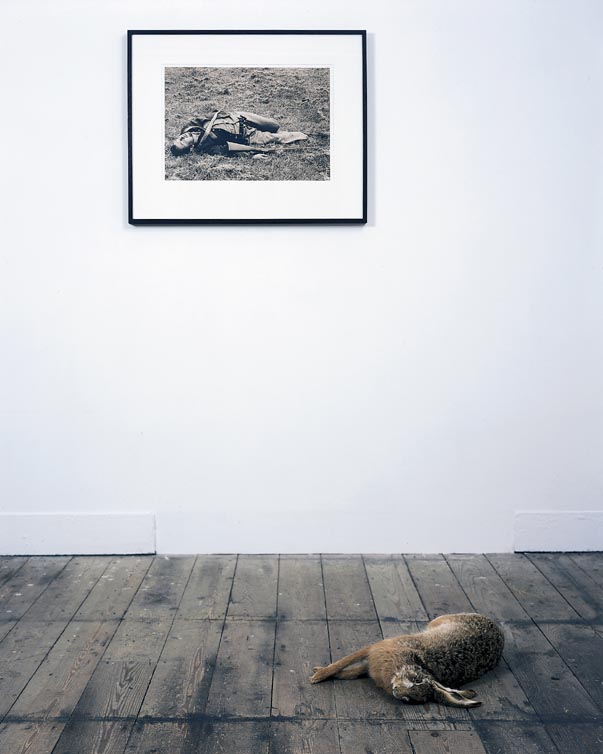
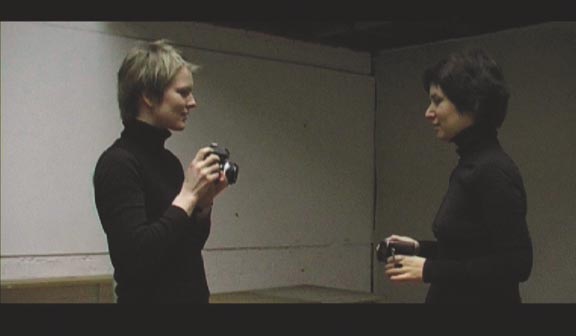
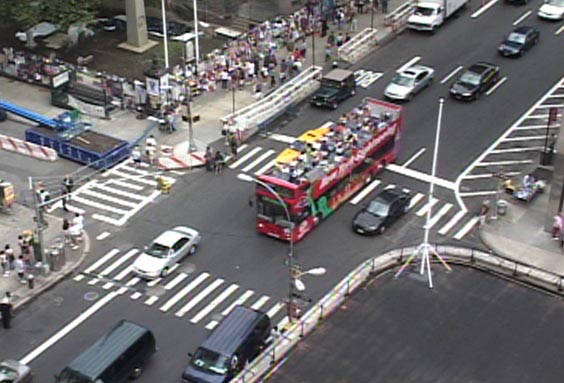
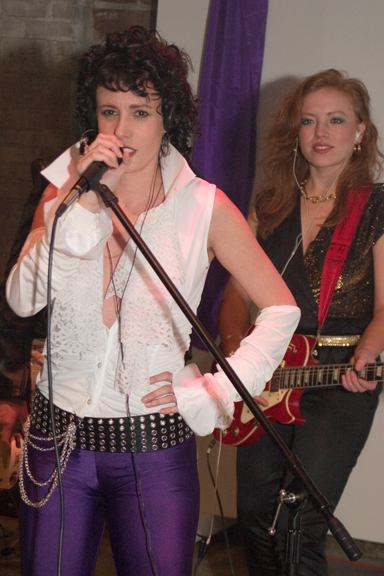
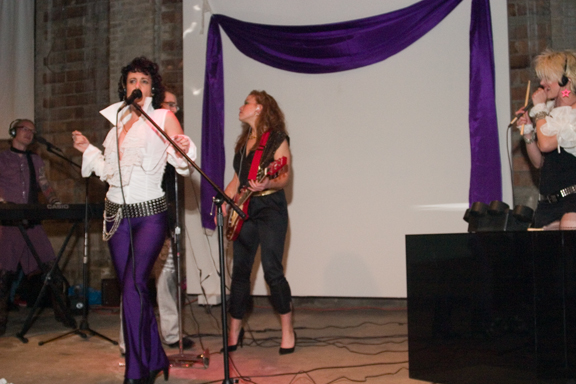
The idea of the “8 x 8 x 8” exhibition at The Soap Factory is to get eight artists from each of three major cities – London, Minneapolis/St. Paul, and New York – and show them together to create a dialogue about the different art scenes in different metropolises. While the intended result is not particularly effective at bringing this off (a casual gallery-goer would be hard pressed to even notice this wrinkle), the exhibition does have a small series of films and photographs that speak to the nature of viewing, being viewed, and the concomitant construction of reality.
Perhaps the most mesmerizing is Sharone Lifschitz’s 2004 video Interluding, in which two women, both dressed in black turtlenecks, photograph each other. The women stand about three feet apart and each holds a manual camera. The expression on their faces is one of affection – sexual, even – but instead of touching or kissing each other, or even talking, they just photograph; the clicking of the shutter is the only sound to the video. One hesitantly poses under the vague direction of the other, a photograph is tentatively taken, and then the roles are reversed: the photographer becomes the subject, a new pose is made, and another picture is taken. It’s as though the most effective way for them to express their mutual adoration is by documenting the other’s existence in a personal, private archive. And, oddly, the collecting of images doesn’t feel contrived or overly mechanical – it seems natural, as though this is what we’d all do.
Furthermore, the scene is complicated by the fact that we, as viewers of the video, are watching the documentation of the documentation. Several times one of the women (the black-haired one on the right) breaks the fourth wall and looks directly at the video camera. She gives an awkward smile. At once it ruins and confirms everything: this is an expression of affection and we are privy to it, and they know we’re watching. It gives the whole endeavor a timidly exhibitionist air, as though they’re ashamed of being viewed, as though we, the viewers, are ashamed of viewing, and yet the whole process is a guilty pleasure for everyone involved – we all like it much better this way.
If Lifschitz’s Interluding shows us how fully image-taking has become a part of our lives, Neil Hamon’s small installation, Lure (Gus Corani, Company B, 9th Kentucky Infantry, 1863) (2002-2003) shows how contrived photographs can be. His piece consists of a taxidermized hare and a photograph of, ostensibly, Gus Corani of the Kentucky Infantry. The hare is placed on the floor in a position that indicates it’s dead, but inside its chest is a small motor that makes it appear to be breathing, if faintly and intermittently. The photograph of Gus Corani is hung on the wall above the hare. It’s sepia-toned, of a soldier laid out on a nondescript battlefield in the same position as the hare. He’s still wearing his Confederate regalia and is presumably dead, though there are no marks of violence on him.
What can we make of all of this? In one sense it seems obvious: the hare, in being resuscitated by the breathing machine, shows us how Gus Corani, of the Kentucky Infantry, continues to ‘live’ via photograph – his image and memory continue even after he’s long gone. He, like the hare, artificially survives. But things are not quite so simple. The photograph of Gus Corani is of dubious vintage. Upon closer inspection, it appears that Mr. Hamon dressed up one of his friends, went out to a grassy field, and made a photograph that looks old-fashioned. This is where the title comes into play: we are the ones being lured. Much like we may think the hare is alive because it is ‘breathing,’ we may believe that Gus Corani was killed in battle because a photograph exists. But, just as the hare is an elaborately contrived ruse, the photograph is a sham – it’s a very well executed trick. Photography, as we need to be continually reminded, is not (as was believed a century and a half ago) a document of unvarnished truth. Lure’s assertion of this fact is both instructive and humbling.
Even more ambitious in its attempt to humble and belittle is Noah Klersfeld’s, Pay Roll (2002-2003), a video that transforms the average citizen into an automaton. The footage is of an intersection in lower Manhattan filmed from three different camera angles. Citizens walk up and down the streets, cars go by, the lights change. A seemingly normal scene, except that it’s narrated by a disembodied voice who sounds as if he’s controlling the movements of every single person at the intersection. For example, the narrator will tell a man in a red shirt, “Now I want you to stop for a second and check your left hip pocket,” or he’ll instruct a taxicab to “Pull through the intersection and merge in front of the limo.” Strangely, all of these seemingly random instructions are heeded – upon the first few seconds of viewing Pay Roll, it appears that some of the people in the video are ‘plants,’ ala Rupert in the beloved David Letterman skit. However, it quickly becomes clear that no one is receiving instructions via earpiece – the narrator is just pretending he’s in control of a pre-recorded scene. And herein lies the problem with Pay Roll. The production quality is so poor (grainy footage, uninteresting cinematography), the voiceover is so mediocre (obviously fake instructions: sometimes the voice cuts in a few seconds too late, sometimes the directions are much too vague, etc), and the plot arc so bland (no clear purpose or intent, invention of legions of unimportant and faceless characters, insincere sense of desperation in the narrator’s voice) that actually watching the video is wickedly boring.
We get the schtick almost immediately: yes, okay, maybe there’s some sort of giant, god-like figure controlling us all – perhaps we’re not as free as we think! …Okay, very clever, but surely the video could be more entertaining. There’s a great deal of comic potential in a godlike voice seeming to direct the every movement of some unsuspecting Joe Blow walking down the street. There’s a certain awe that could be inspired by a concise and accurate description of traffic patterns. Narratives and minor plots could get constructed out of quotidian scenes: so-and-so needs to cross the street. How will this get done? Who will contribute what? …In other words, a sense of play, a much higher production quality, a better narrator, and more care for the interest of the viewer would make the piece more complete. As it is, Pay Roll is much better as an idea than in practice.
Similarly ineffective because of low-quality execution is Emily Lutzker’s installation I ♥ U Prince (2006). On the opening night of the “8 x 8 x 8” exhibition, Lutzker dressed up like the famed Minnesota-born singer and performed a few of Prince’s songs on a makeshift stage. Currently, a video of the performance is projected on one wall of the gallery, adjacent to a constructed dressing room/living room area that the gallery-goer can walk through. A large mirror in the living room area reflects the video, while a Summit and a Jose Cuervo bottle sit on an end table and coffee table, respectively. Electrical cables, jewelry, clothes, and hairpins are strewn across a couch and dresser top. The scene sets up to have potential for interest: here we have someone pretending to be someone else, and we can be in her private space, her dressing room. Reflected in the mirror we see her in action, performing as Prince. Here, in this room, is where she can be herself, and yet it’s here where we see that she most desires to be somebody else. There’s potential…
And yet, Lutzker’s rendition of Prince on video is so poor that it’s hard to take the piece seriously. Is this the fruit of obsession? The average singer at karaoke night would far outshine Lutzker’s imitation, while her costume and dance moves are plainly half-assed; a decent performer at a drag show would put Lutzker’s effort to shame. And the camera work, whether intentionally lo-fi or not, looks like something straight out of America’s Funniest Home Videos. How can we believe in the obsessive, how can we delve into her world when she herself seems to be, at best, lukewarm about imitating Prince? There’s no fun here, no heart, no follow through – if the artist herself isn’t invested in it, it’s hard for anyone else to feel much of anything either.
The show, “8 x 8 x 8,” suffers from this uneven quality. Some of the artists are clearly much more technically skilled and emotionally invested in their work than others. The sprawling nature of The Soap Factory gallery, combined with the enormous number of artists included in the show and the seemingly indifferent curating serve to highlight how disparate and frustrating the contemporary art scene can be. But, if “8 x 8 x 8” is mimetic of the contemporary art scene at large, it then does have this happy quality: amidst the dreck there are also plenty of worthwhile pieces.